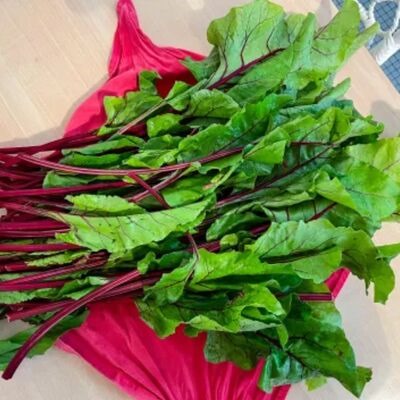ADVERTISEMENT
#### **2. A Good Source of Fiber**
Fiber is important for digestive health, heart health, and maintaining a healthy weight. Beet greens are a great source of both soluble and insoluble fiber. Soluble fiber helps to lower cholesterol levels, while insoluble fiber aids in digestion and helps prevent constipation.
– **Digestive Health**: The fiber in beet greens promotes healthy digestion and regular bowel movements, ensuring your digestive system stays in top shape.
– **Blood Sugar Control**: Fiber helps slow down the absorption of sugar into the bloodstream, helping to stabilize blood sugar levels and prevent spikes, which is especially beneficial for those with diabetes or anyone trying to maintain energy levels throughout the day.
#### **3. Antioxidants for Cellular Health**
Beet greens are also rich in antioxidants, particularly flavonoids and carotenoids, which have been shown to protect cells from damage caused by free radicals. Antioxidants can help reduce inflammation and lower the risk of chronic diseases, including heart disease, cancer, and neurodegenerative disorders.
– **Lutein and Zeaxanthin**: These carotenoids are particularly beneficial for eye health, reducing the risk of macular degeneration and protecting against oxidative damage in the eyes.
– **Betalains**: While betalains are more commonly associated with the beetroot, beet greens also contain these compounds, which have anti-inflammatory and detoxifying properties.
#### **4. Supports Heart Health**
Thanks to their rich content of potassium, magnesium, and fiber, beet greens contribute to heart health by helping to regulate blood pressure and reduce the risk of cardiovascular diseases. Potassium helps balance sodium levels in the body, which can aid in lowering blood pressure and improving heart function.
– **Reduced Risk of Hypertension**: Potassium and magnesium work together to relax blood vessels, improving blood flow and reducing the risk of high blood pressure. By adding beet greens to your diet, you can help promote a healthy heart and reduce the strain on your cardiovascular system.
### **How to Incorporate Beet Greens into Your Diet**
Now that you know how nutritious beet greens are, it’s time to learn how to use them in your meals. Beet greens are versatile and can be prepared in a variety of ways. Here are some simple and delicious ideas for incorporating them into your diet:
#### **1. Sautéed Beet Greens**
One of the easiest ways to enjoy beet greens is by sautéing them. This method preserves the greens’ flavor and nutrients while making them tender and delicious.
**Sautéed Beet Greens Recipe:**
– Heat 1-2 tablespoons of olive oil in a large pan over medium heat.
– Add a clove of minced garlic and sauté for 1-2 minutes until fragrant.
– Add a bunch of chopped beet greens (stems and leaves) to the pan and sauté for 5-7 minutes until the greens are wilted and tender.
– Season with salt, pepper, and a squeeze of lemon juice for added brightness.
#### **2. Beet Green Salad**
Beet greens can be used fresh in salads. The young, tender leaves are perfect for adding a mild, earthy flavor to your salad mix.
**Fresh Beet Green Salad Recipe:**
– Wash and dry the beet greens, then tear them into bite-sized pieces.
– Toss the greens with other salad ingredients like arugula, spinach, or mixed greens.
– Add your favorite toppings, such as cherry tomatoes, cucumbers, nuts, and cheese.
– Dress with a light vinaigrette made from olive oil, balsamic vinegar, Dijon mustard, and honey.
#### **3. Add to Smoothies**
For a nutrient boost, you can toss beet greens into your morning smoothie. They’ll blend seamlessly with fruits like berries, bananas, and apples while adding a punch of vitamins and minerals.
For Complete Cooking STEPS Please Head On Over To Next Page Or Open button (>) and don’t forget to SHARE with your Facebook friends
